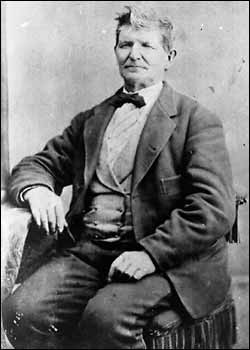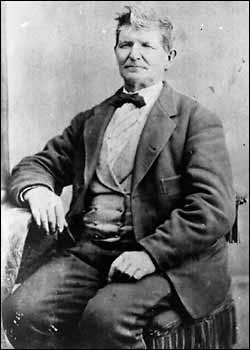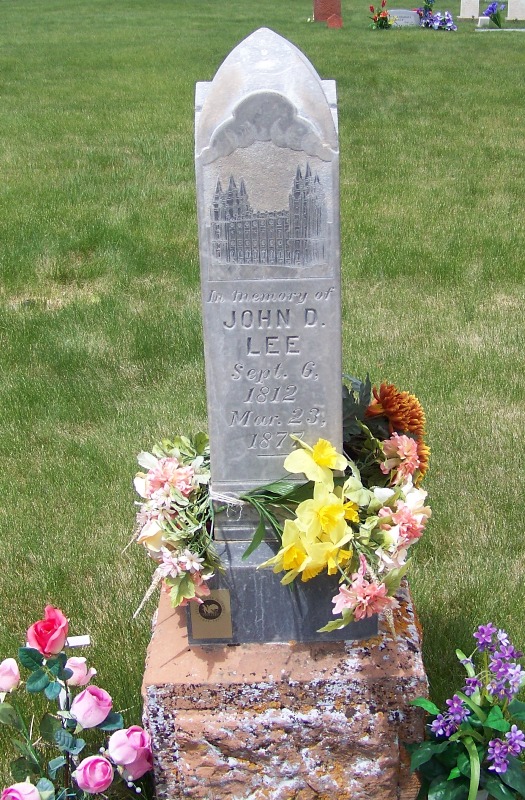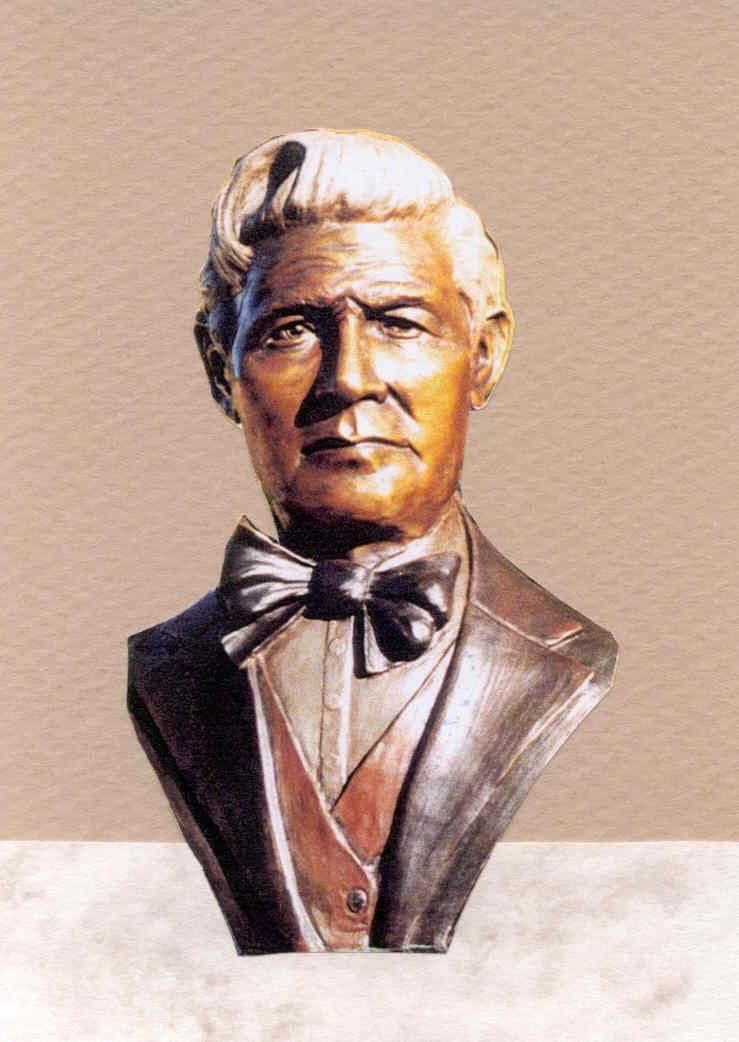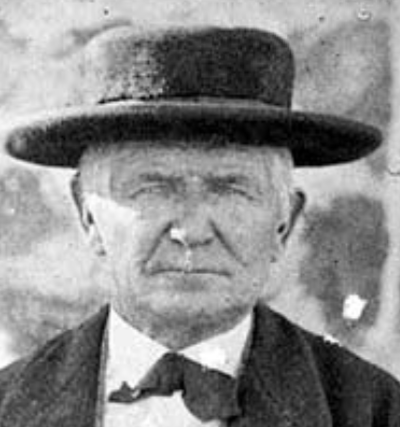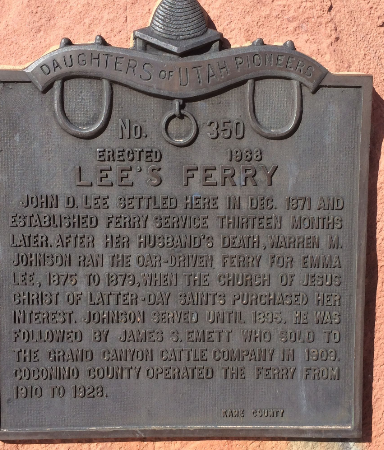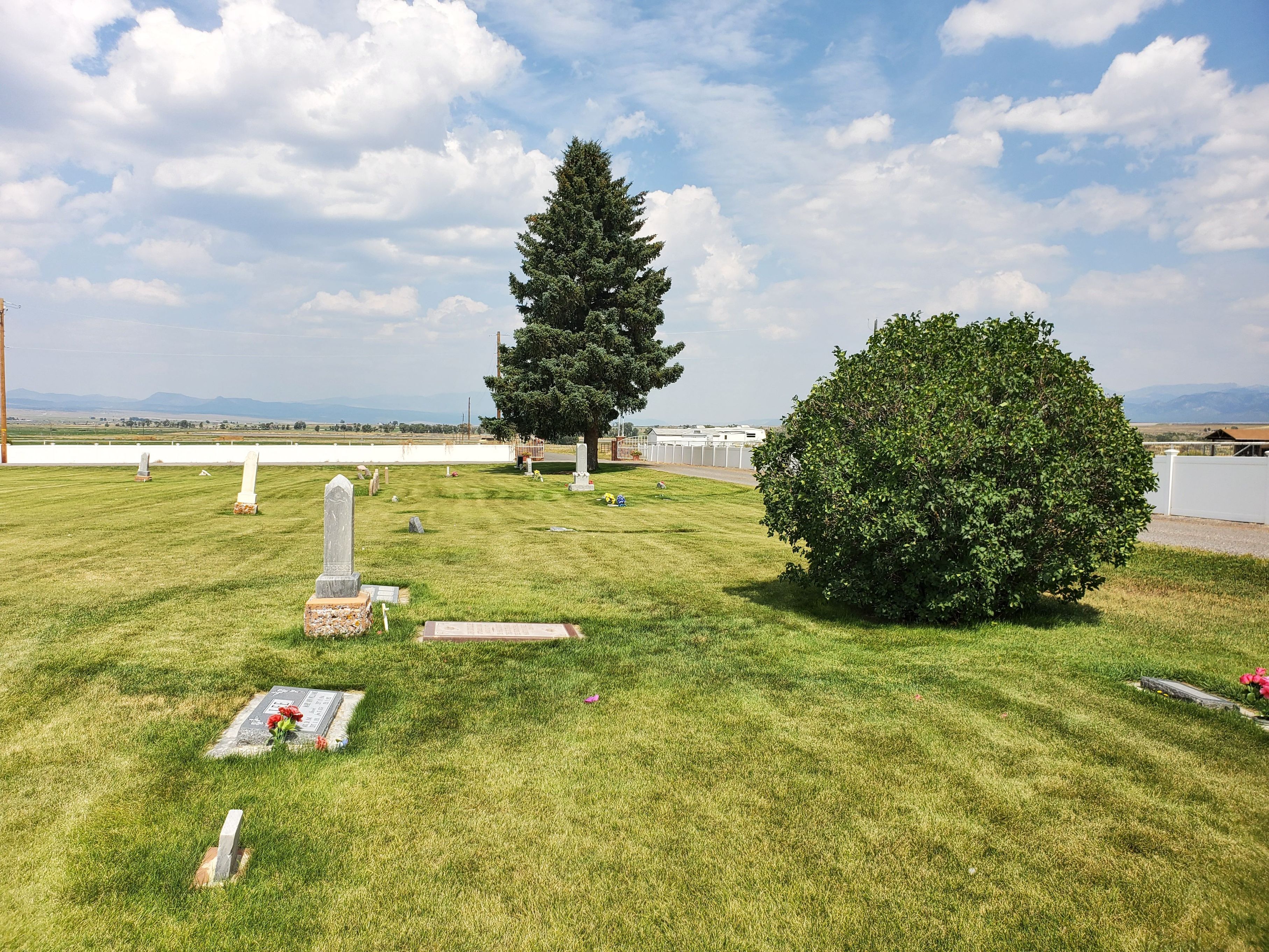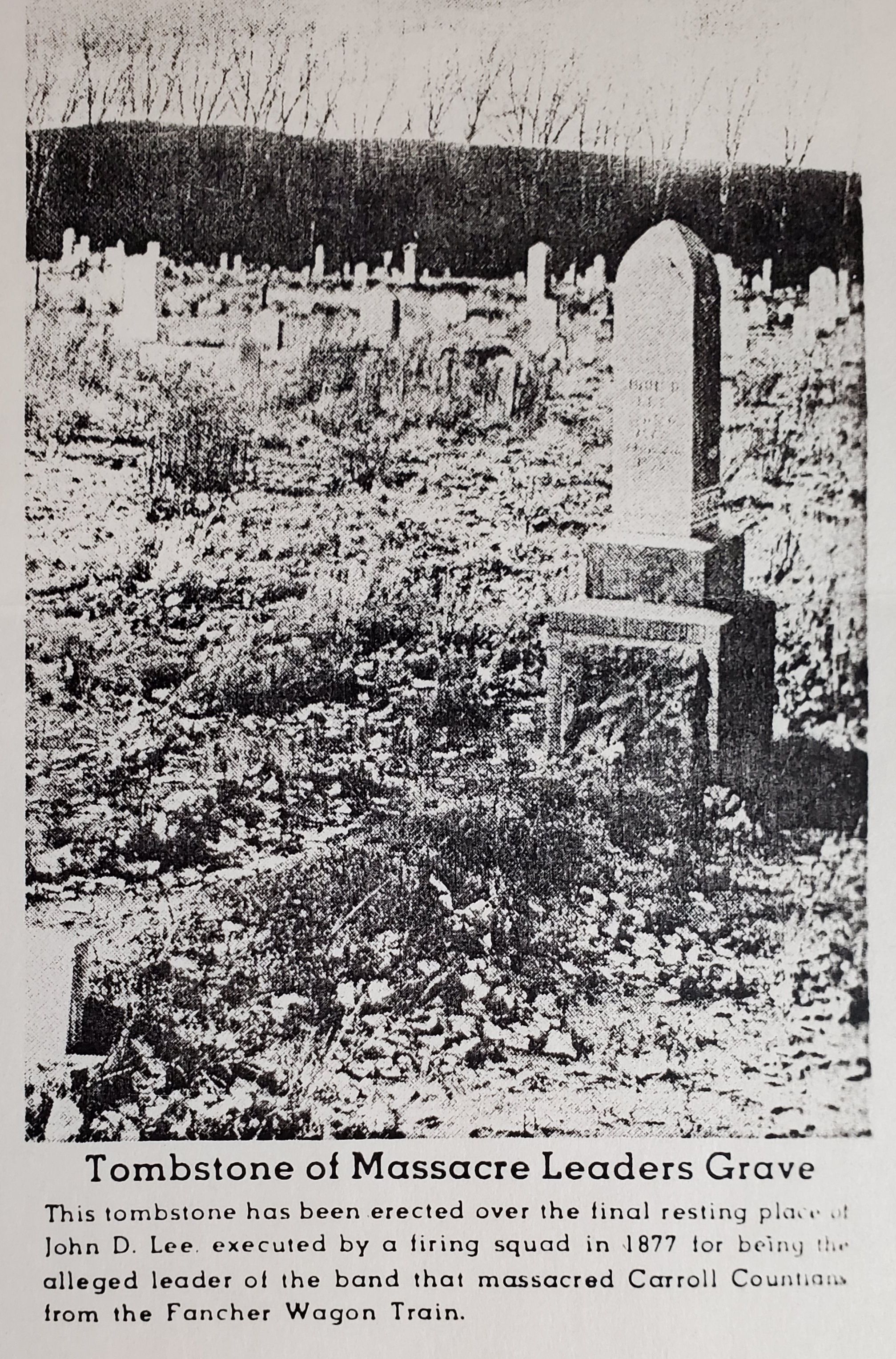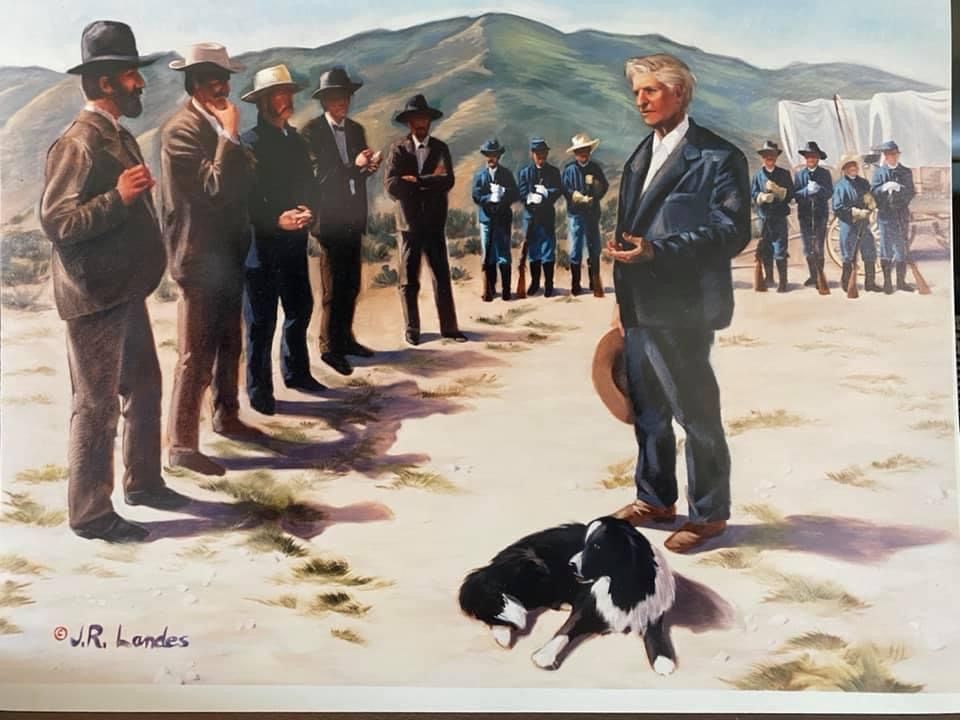Born in 1812 in Kaskaskia, Illinois Territory, Lee had a tumultuous childhood. At age three, his mother died after years of lingering illnesses, leaving Lee to his alcoholic father. From age seven to sixteen Lee was raised in an uncle's family. He worked for a time as a mail carrier before assuming managerial responsibility for his uncle's farm, then worked several years as a store clerk in Galena, Illinois. Finally, Lee moved to Vandalia, Illinois, where he met and married Agatha Ann Woolsey in 1833.
It was in Vandalia that Lee and his wife encountered Mormonism. In 1837 a Mormon missionary converted the couple to the young religion, which had been formally organized only seven years before. Lee's religious passion quickly became the driving force in his life, prompting him to move in 1838 to a homestead near the Mormon town of Far West, Missouri.
The large influx of Mormons into Northwest Missouri caused enormous tensions with the non-Mormon ("gentile") population. Individual confrontations soon exploded into near warfare involving murder, destruction of property, and cycles of raids and counter-raids between the Mormons and gentiles. Lee played an active role in many of the military conflicts, and soon became a member of the Danite Band, the formally organized Mormon militia. Finally Missouri's governor ordered the Mormons expelled or exterminated.
As the Mormons began preparing for their trek eastward to Nauvoo, Illinois, Lee's religious devotion continued to strengthen. In 1838 he was promoted within the priesthood and made a member of the First Quorum of the Seventy. From 1839 to 1844 he spent much of his time winning converts in Illinois, Tennessee and Kentucky. In 1843 he was chosen to guard the home of the church's founder and prophet, Joseph Smith.
John Lee's religious fervor only grew in intensity as the young religion entered its darkest hour. In June 1844 a mob dragged Joseph Smith and his brother from their jail cell in Carthage, Illinois, and murdered them, causing a crisis of leadership within the church. In addition, there was internal dissension over the doctrine of plural marriage, which had been formally announced within the church in 1843. Lee accepted the new doctrine, soon taking five more wives, and he remained devotedly loyal to the church leadership, especially the new leader, Brigham Young, whom Lee assisted during the Mormon flight to the "Winter Quarters."
By 1846 the Mormons, decided to seek their own Zion in the American West. By 1847 the first wagons began arriving in Utah's Salt Lake valley. Lee joined the gathering masses of Zion in Utah.
For the next decade, Lee played an important role in expanding the Mormon refuge in the West. He became a prosperous farmer and businessman in Southwestern Utah, helping to establish communal mining, milling and manufacturing complexes. He became the local bishop and the Indian agent to the nearby Paiute Indians. And he continued to be a frequent visitor and trusted confidant of the church leadership in Salt Lake City.
Even in the far West, however, neither Lee nor his co-religionists were beyond the reach of the country whose persecution they had fled. In 1857, prompted by complaints about church power in the territory and a public outcry against polygamy, the United States sent an army to Utah, raising Mormon fears that the final annihilation was at hand. This invasion was the backdrop for the still-controversial Mountain Meadows Massacre, in which a wagon train of about 120 gentile immigrants, suspected of hostility toward the church, was destroyed by Mormon and Paiute forces in southwestern Utah.
Lee's involvement in the massacre -- the extent of which is still vigorously disputed and will probably never be known -- was to haunt him for the next two decades, and would ultimately lead to his execution. In 1858 a federal judge came to southwestern Utah to investigate the massacre and Lee's part in it, but Lee went into hiding and local Mormons refused to cooperate with the investigation. Folk songs dating back to this year blamed Lee for the massacre.
Although the church sought to lower Lee's profile, by removing him as a probate judge, the Mormon leadership continued to return his immense loyalty. In 1860, Brigham Young visited one of Lee's mansions and publicly praised his personal industriousness and communal economic contributions. In 1861 the residents of Harmony, Utah, elected him as their presiding elder.
But Lee could not escape the legacy of Mountain Meadows. In 1870 a Utah paper openly condemned Brigham Young for covering up the massacre. That same year Young exiled Lee to a remote part of northern Arizona and excommunicated him from the church.
The next several years brought a continued decline in Lee's fortunes. He had several episodes of severe illness; drought followed by torrential rains destroyed many of his buildings and crops; former neighbors preyed upon his livestock and otherwise took advantage of his absence; several of his wives deserted him. Nevertheless, he was managing to eke out a living in a homesteader's cabin near the Colorado River in Northern Arizona (at one point hosting John Wesley Powell's 1869 expedition before their trip through the Grand Canyon) when a sheriff captured him in November 1874.
Lee's first trial ended inconclusively with a hung jury. A second trial, in which the prosecution placed the blame squarely on Lee's shoulders, ended with his conviction. The trials were the subject of enormous public attention and gave rise to many accounts of the massacre and of Lee's life. Lee himself continued to profess his innocence. Nearly twenty years after the massacre, Lee was executed at Mountain Meadows.
(PBS-The West Film Project, 2001)
Born in 1812 in Kaskaskia, Illinois Territory, Lee had a tumultuous childhood. At age three, his mother died after years of lingering illnesses, leaving Lee to his alcoholic father. From age seven to sixteen Lee was raised in an uncle's family. He worked for a time as a mail carrier before assuming managerial responsibility for his uncle's farm, then worked several years as a store clerk in Galena, Illinois. Finally, Lee moved to Vandalia, Illinois, where he met and married Agatha Ann Woolsey in 1833.
It was in Vandalia that Lee and his wife encountered Mormonism. In 1837 a Mormon missionary converted the couple to the young religion, which had been formally organized only seven years before. Lee's religious passion quickly became the driving force in his life, prompting him to move in 1838 to a homestead near the Mormon town of Far West, Missouri.
The large influx of Mormons into Northwest Missouri caused enormous tensions with the non-Mormon ("gentile") population. Individual confrontations soon exploded into near warfare involving murder, destruction of property, and cycles of raids and counter-raids between the Mormons and gentiles. Lee played an active role in many of the military conflicts, and soon became a member of the Danite Band, the formally organized Mormon militia. Finally Missouri's governor ordered the Mormons expelled or exterminated.
As the Mormons began preparing for their trek eastward to Nauvoo, Illinois, Lee's religious devotion continued to strengthen. In 1838 he was promoted within the priesthood and made a member of the First Quorum of the Seventy. From 1839 to 1844 he spent much of his time winning converts in Illinois, Tennessee and Kentucky. In 1843 he was chosen to guard the home of the church's founder and prophet, Joseph Smith.
John Lee's religious fervor only grew in intensity as the young religion entered its darkest hour. In June 1844 a mob dragged Joseph Smith and his brother from their jail cell in Carthage, Illinois, and murdered them, causing a crisis of leadership within the church. In addition, there was internal dissension over the doctrine of plural marriage, which had been formally announced within the church in 1843. Lee accepted the new doctrine, soon taking five more wives, and he remained devotedly loyal to the church leadership, especially the new leader, Brigham Young, whom Lee assisted during the Mormon flight to the "Winter Quarters."
By 1846 the Mormons, decided to seek their own Zion in the American West. By 1847 the first wagons began arriving in Utah's Salt Lake valley. Lee joined the gathering masses of Zion in Utah.
For the next decade, Lee played an important role in expanding the Mormon refuge in the West. He became a prosperous farmer and businessman in Southwestern Utah, helping to establish communal mining, milling and manufacturing complexes. He became the local bishop and the Indian agent to the nearby Paiute Indians. And he continued to be a frequent visitor and trusted confidant of the church leadership in Salt Lake City.
Even in the far West, however, neither Lee nor his co-religionists were beyond the reach of the country whose persecution they had fled. In 1857, prompted by complaints about church power in the territory and a public outcry against polygamy, the United States sent an army to Utah, raising Mormon fears that the final annihilation was at hand. This invasion was the backdrop for the still-controversial Mountain Meadows Massacre, in which a wagon train of about 120 gentile immigrants, suspected of hostility toward the church, was destroyed by Mormon and Paiute forces in southwestern Utah.
Lee's involvement in the massacre -- the extent of which is still vigorously disputed and will probably never be known -- was to haunt him for the next two decades, and would ultimately lead to his execution. In 1858 a federal judge came to southwestern Utah to investigate the massacre and Lee's part in it, but Lee went into hiding and local Mormons refused to cooperate with the investigation. Folk songs dating back to this year blamed Lee for the massacre.
Although the church sought to lower Lee's profile, by removing him as a probate judge, the Mormon leadership continued to return his immense loyalty. In 1860, Brigham Young visited one of Lee's mansions and publicly praised his personal industriousness and communal economic contributions. In 1861 the residents of Harmony, Utah, elected him as their presiding elder.
But Lee could not escape the legacy of Mountain Meadows. In 1870 a Utah paper openly condemned Brigham Young for covering up the massacre. That same year Young exiled Lee to a remote part of northern Arizona and excommunicated him from the church.
The next several years brought a continued decline in Lee's fortunes. He had several episodes of severe illness; drought followed by torrential rains destroyed many of his buildings and crops; former neighbors preyed upon his livestock and otherwise took advantage of his absence; several of his wives deserted him. Nevertheless, he was managing to eke out a living in a homesteader's cabin near the Colorado River in Northern Arizona (at one point hosting John Wesley Powell's 1869 expedition before their trip through the Grand Canyon) when a sheriff captured him in November 1874.
Lee's first trial ended inconclusively with a hung jury. A second trial, in which the prosecution placed the blame squarely on Lee's shoulders, ended with his conviction. The trials were the subject of enormous public attention and gave rise to many accounts of the massacre and of Lee's life. Lee himself continued to profess his innocence. Nearly twenty years after the massacre, Lee was executed at Mountain Meadows.
(PBS-The West Film Project, 2001)
Family Members
-
![]()
Agatha Ann Woolsey Lee
1814–1866 (m. 1833)
-
![]()
Nancy Bean Decker
1826–1903 (m. 1844)
-
![]()
Louisa Free Wells
1824–1886 (m. 1845)
-
![]()
Sarah Caroline Williams Young
1830–1907 (m. 1845)
-
![]()
Martha Elizabeth Berry Dorrity
1827–1885 (m. 1846)
-
![]()
Mary Ann Workman Bennett
1829–1904 (m. 1846)
-
![]()
Nancy Gibbons Armstrong
1799–1847 (m. 1847)
-
![]()
Lovina Young Lee
1820–1884 (m. 1847)
-
![]()
Mary Vance "Polly" Young Lee
1817–1890 (m. 1847)
-
![]()
Rachel Andora Woolsey Lee
1825–1912 (m. 1851)
-
![]()
Mary Leah Groves Matthews
1836–1912 (m. 1852)
-
![]()
Mary Ann Williams Lee
1844–1882 (m. 1857)
-
![]()
Emma Batchelor French
1836–1897 (m. 1858)
-
![]()
Terressa Morse Phelps
1813–1882 (m. 1859)
-
![]()
Ann "Annie" Gordge Kenney
1849–1923 (m. 1864)
-
![]()
Sarah Jane Lee Underwood
1838–1915
-
![]()
John Alma Lee
1840–1881
-
![]()
Mary Adeline Lee Darrow
1841–1924
-
![]()
Joseph Hyrum Lee
1844–1932
-
John Heber Lee
1846–1847
-
John Brigham Lee
1846–1856
-
![]()
Cornelia Lee Decker Mortensen
1846–1937
-
![]()
John Willard Lee
1849–1923
-
![]()
Harriet Josephine Lee Bliss
1850–1922
-
![]()
Nancy Emily Lee Dalton
1850–1930
-
![]()
Louisa Evelyn Lee Prince
1850–1932
-
![]()
Elizabeth Lee Pace
1851–1912
-
![]()
John David Lee
1851–1922
-
William Orson Lee
1852–1908
-
![]()
Ellen S Lee Clark
1852–1924
-
![]()
Harvey Parley Lee
1852–1927
-
![]()
James Young Lee
1852–1939
-
![]()
Helen Rachel "Nellie" Lee Stocks
1852–1943
-
![]()
Samuel Gully Lee
1853–1896
-
![]()
Armelia Lee
1854–1860
-
![]()
Erastus Franklin Lee
1854–1914
-
![]()
George Albert Lee
1855–1862
-
![]()
George Albert Lee
1855–1862
-
![]()
Thirza Jane Lee Anderson
1855–1894
-
![]()
Melvina Young Lee Clark
1856–1920
-
![]()
Mariam Leah Lee Cornelius
1856–1942
-
![]()
Rachael Amorah Lee Smithson
1856–1945
-
![]()
Margaret A Ann Lee
1857–1862
-
![]()
Margaret Ann Lee
1857–1862
-
![]()
Ezra Taft Lee
1857–1925
-
Henrietta Lee
1858–1860
-
![]()
Lucy Olive Lee Maloney
1858–1922
-
![]()
Rachel Olive Lee Norton
1858–1924
-
![]()
John Henry Lee
1859–1859
-
![]()
William James Lee
1860–1920
-
![]()
Sarah Ann Lee Young
1860–1920
-
![]()
John Hurd Lee
1860–1938
-
![]()
John Amasa Lee
1860–1939
-
![]()
Elisha Squire Lee
1862–1937
-
![]()
Charles William Lee
1862–1941
-
![]()
William Franklin Lee
1862–1946
-
Isaac L. "Ike" Lee
1863–1892
-
![]()
Mary Elizabeth Lee Lamb
1864–1941
-
![]()
Mary Serepta Lee Bliss
1865–1897
-
Samuel James Lee
1865–1937
-
![]()
Josephine Helen Lee Jorgensen
1865–1947
-
![]()
Robert Edmond Lee Sr
1866–1928
-
Rachel Emma Lee
1866 – unknown
-
![]()
Jacob Lee
1867–1947
-
Joseph Willard Brigham ""Brig"" Lee
1868–1916
-
![]()
Merab Emma ""Belle"" Lee Morris
1868–1945
-
![]()
Walter Brigham Lee
1869–1939
-
Frances Dell Lee
1872–1888
-
![]()
Albert Doyle Lee
1872–1921
-
![]()
Ammon Doyle Lee
1872–1940
-
![]()
Victoria Elizabeth Lee
1873–1888
